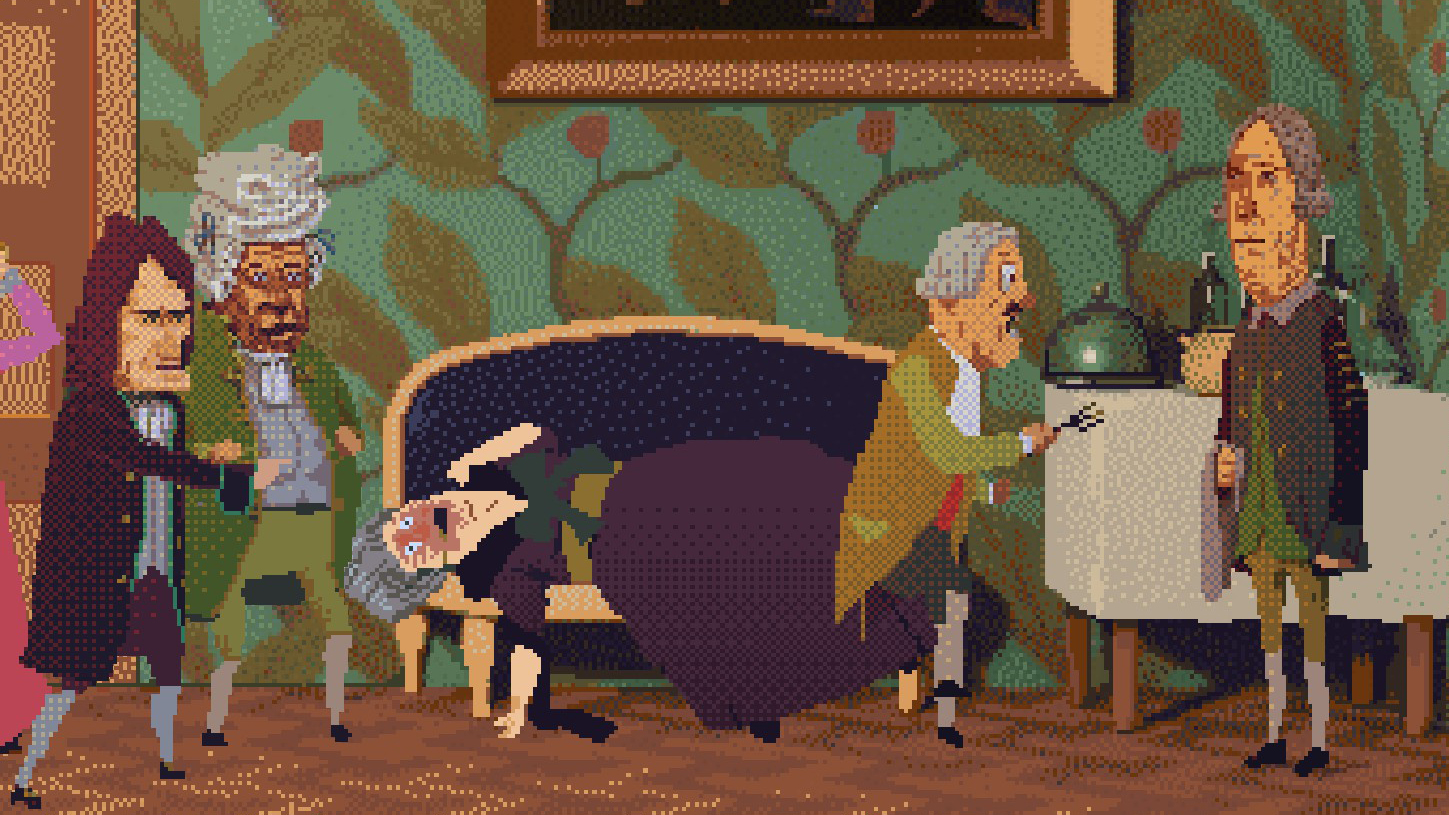
Solve a string of grisly murders in this inventive detective adventure.
What is it? A murder mystery adventure game
Expect to pay: $18/£16.99
Developer: Color Gray Games
Publisher: Playstack
Reviewed on: RTX 2080, Intel i7-9700K, 16GB RAM
Multiplayer? No
Out: Now
Link: Official site
A woman lies dead on a sofa, her mouth open in shock. Some members of the dinner party she was attending stare in horror while others level angry accusations at each other. Only one person is smiling happily, and that’s me, the detective. I’ve got another intriguing murder to solve in The Case of the Golden Idol, one of the most novel and challenging mystery games I’ve played in years.
I begin my investigation, clicking on anything and everything, starting with the guests. They’re frozen in time, stuck in the moment the victim perished, so I’m free to go through their pockets with my mouse pointer to peer at their coins, rings, and monogrammed handkerchiefs. Then I move downstairs to the two maids standing in the kitchen so I can examine the notes and letters they’re carrying. A waste bin contains discarded correspondence, a dinner table holds unfinished meals, and most interestingly, a pouch dangles on a rope outside a window as if someone was trying to conceal something from the rest of the household.
Over the next hour I slowly piece together the identities of each person, then figure out which room in the house is theirs so I can match them to their possessions. I even figure out where each person was sitting at the dinner table when the murder took place. I learn who masterminded it, who carried it out and for what reason, not to mention a few interesting plot twists along the way. This murder, and likewise this entire game, is a darkly brilliant tale told in discrete clues, and it makes me feel pretty clever for piecing them together and figuring it out.
The Case of the Golden Idol begins with a simple murder, one man shoving another off a cliff. To investigate, you click on clues in the scene of the murder, and within those clues you click on words. A journal or note might contain a first or last name. A pocket may (and usually does) contain a weapon like a pistol or blade, a fireplace may have a scrap of a will someone hastily tried to dispose of. Carefully looking through the scene and clicking on clues leaves you with a collection of words at the bottom of your screen, words like sword, stabbed, pushed, button, or trapdoor, along with all the names of the characters you’ve discovered.
Tapping the space bar swaps from exploring the murder scene into “thinking” mode where you can drag and drop the words you’ve collected into blanks to solve the crime. A scroll on the left contains the description of the events: Blank murdered blank on blank island, for example. Murder via Mad Libs. All you need to do to proceed to the next case is correctly fill in the murder scroll, one word at a time.
Circumspective evidence
But there are bonus objectives: In the middle of the thinking screen is a portrait gallery where you can match faces with first and last names, which brings to mind another brilliant mystery game, Return of the Obra Dinn. In later cases the right side of the screen has slots for more details: who was sitting where at a dinner table, for example. It’s well-worth filling in everything because some characters will appear again in later murders, and knowing them make a future investigation a bit easier.
(Image credit: Color Gray Games)
The cases—there are a dozen—immediately grow more elaborate and intricate, involving more suspects, murkier motives, tons of unrelated clues, and plenty of secrets. Clues can come not just from the words you gather but from the details of oddly illustrated scenes themselves. Even scouring a scene multiple times, it would sometimes still take me ages to notice the smaller, finer details like a tattoo on someone’s wrist or initials in a ledger. Even the minimalist animation of the scene can help you figure out what happened, like the way someone’s eyes are moving, even if it’s not a clue you can click on.
My favorite case feels like a classic mystery novel setup: A body is found in the parlor of a sprawling manor, with an odd collection of suspects to choose from (including a butler, naturally), and there’s some all-too-convenient evidence pointing at one likely perpetrator. A detective has been called and he’s been interviewing everyone in the house as to their whereabouts at the time of the murder… but since I’m the real detective of the game, I get to look through the visiting detective’s notebook and use his notes to help me solve the case. Good work, but I’ll take it from here, pal.
(Image credit: Color Gray Games)
Paired with the satisfaction that comes from solving a complicated crime and moving on to the next, there’s a long and fascinating story running through these murders, all centered around the Golden Idol itself. The idol is no mere trinket or mcguffin but an arcane object of magic and power, and with each murder I learned more about the mysterious idol, what it’s capable of, and why so many people feel it’s worth committing brutal killings to possess.
As the years pass, the idol’s secrets are slowly unlocked and its powers are used in fascinating ways, and the idol’s owners grow in power and prestige. It makes solving these murders not just a fantastic series of crime-scene investigations but an highly imaginative bit of storytelling. I don’t say this about a lot of games, but The Case of the Golden Idol would make one hell of a novel.
C.S.Idol
(Image credit: Color Gray Games)
The Case of the Golden Idol would make one hell of a novel.
There were a couple cases that didn’t entirely come together for me. In one I couldn’t fully figure out the motive, and even after solving the case I’m not even sure how I was meant to figure out the motive.
I also wound up occasionally brute-forcing the final few names or details of a case, trying every possible combination with the empty slots, adventure-game style. There’s also a particular case near the very end I didn’t much care for at all, partly because it made me do math (unforgivable) and partly because most of it wound up feeling like data entry rather than an elaborate murder investigation.
(Image credit: Color Gray Games)
But just because a few pieces didn’t fall perfectly into place didn’t stop the overall story of The Case of the Golden Idol from reaching a satisfying end, and it didn’t stop me from loving this inventive detective adventure. I only wish there was a “randomize absolutely everything” button so I could figure it out all over again.






